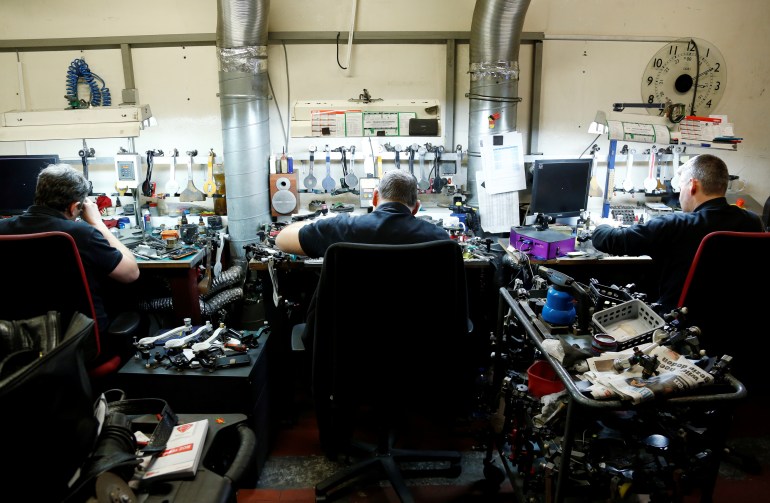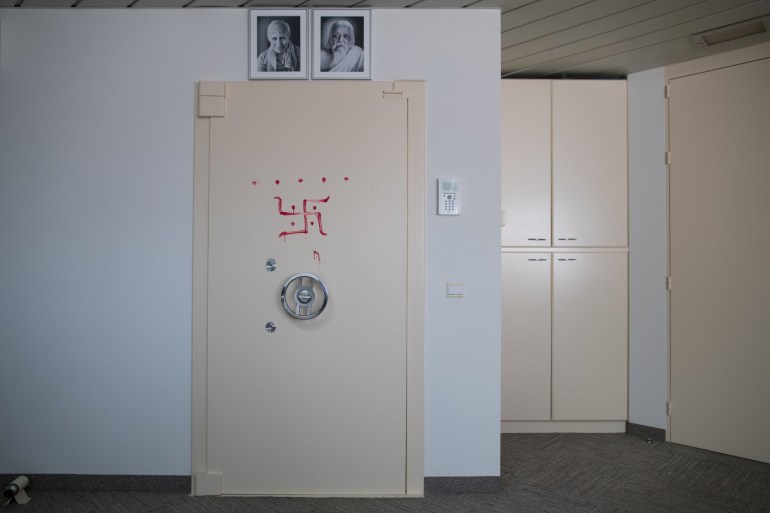“You can enjoy nice things in life, but it’s about doing it in a good manner, and being a gentle human being,” says Akash, seated at a table opposite me, as he tucks into a plate of curried vegetables. “It’s the difference between cutting something’s hair or nails and cutting its throat. Control yourself. Take only what you need. That’s the Jain philosophy.”
Akash’s humble vegetarian diet is a reflection of his devout faith. The Jain commitment to non-violence is so highly tuned that monks and nuns sweep the ground before them to avoid stepping on insects. Religious figures and lay people alike – Akash included – follow a strict vegetarian diet, catered for by restaurants like Aahaar. Even root vegetables are prohibited, because harvesting them kills the plant.
‘Purely business’
The majority of Antwerp’s Jains have their roots in the city of Palanpur in the western Indian state of Gujarat, although Akash himself grew up in Udaipur, a city famous for its palaces and lakes in the desert state of Rajasthan. The Jains’ reasons for moving to Belgium, he tells me, were solely business-based.
“In India, the diamond business is commanded by the Jain community, so when they found opportunities here in Antwerp, or in Hong Kong, New York, Tokyo – they moved,” he says. “It all depends on business conditions, and Antwerp is the diamond business hub. Here they found that the government, the facilities are favourable for business. Purely business.”

Antwerp’s Jains are a quiet community who keep themselves to themselves, largely mixing with outsiders only to do business. Most of them live in the suburb of Wilrijk, in the vicinity of the city’s Jain temple.
Alcohol is forbidden, so Jains are unlikely to be found enjoying Antwerp’s bustling nightlife scene; rather, their social lives are centred around home, the temple, and Jain-friendly restaurants such as Aahaar and Sangeetha, another popular vegetarian place.
The professional world in which Akash works, however, along with many of Antwerp’s 1,500-strong Jain community, is anything but humble.
Jains dominate Antwerp’s diamond industry, the most lucrative and influential in the world, having slowly taken over from the Orthodox Jewish community over the past 60 years. So how does a faith based on moderation and non-attachment to material things, have come to dominate this most glittery and profane of professions?
“Jewellery and diamonds are in my blood,” says Akash with a self-effacing smile. “My parents and grandparents were in the business of precious metals, bullion and pearls in India. The Jain community is traditionally very highly educated; they are mostly in business, management, finance and accounting. Since ancient times, Jains have been trading in gems, diamonds, spices and clothes.”

Trading, not manufacturing
Jainism originated in India thousands of years ago, and is one of the oldest extant religions in the world. Jains only make up about 0.4 percent of the Indian population but are disproportionately influential within the country, especially in the world of business. Many, like Akash, bear the surname “Jain”, but many others don’t.
Gautam Adani, India’s second-richest – and the world’s 23rd most wealthy – person is Jain, as is Amit Shah, the country’s powerful home minister who is widely seen as Prime Minister Narendra Modi’s second-in-command.
“Our main teachings are: truth; ahimsa (non-violence); and aparigraha (non-possession) – not taking what you don’t need,” says Akash. “Don’t get attached to physical things; money, land, things like that.”
“In Jainism you have these big ethical injunctions which have led to rules about which jobs are acceptable,” says Professor Tine Vekemans, an expert in Jainism at Ghent University. “They would never work as butchers or leatherworkers, nor traditionally in agriculture – there’s a lot of potential violence with pulling things out of the ground, damaging little creatures in the soil.”
Mining diamonds is not exactly eco-friendly either, of course. “That’s why Jains are into trading, not manufacturing,” says Akash. “Less direct.”
Jains have also taken steps to counter the unethical elements of the industry and to stymie the flow of “conflict diamonds”.
“Jain diamond firms have done a lot of work looking at the source of their diamonds and for anything in the supply line which may be unethical,” says Vekemans. They were influential in the development and application of the Kimberley Process; India, where the diamond trade is also dominated by Jains, was one of the founding members of this international certification scheme which aims to eradicate conflict diamonds from the industry. Furthermore, Dilip Mehta, the Jain CEO of Rosy Blue, one of Antwerp’s largest diamond companies, has advocated for expanding the definition of “conflict diamonds” in his role as a director of the World Diamond Council.
Hushed conversations in marble corridors
Tucked away in the shadow of Antwerp’s grand Art Nouveau railway station, the Diamond Quarter is an unprepossessing cluster of boxy, grey and brown buildings dating back to the 1960s and ‘70s. It’s a modest setting for the capital of the world diamond industry – a title Antwerp has claimed since 1456 when jeweller Lodewyk van Bercken infused his polishing wheel with olive oil and diamond dust to invent the scaif, a revolutionary tool which allowed for the cutting of perfectly symmetrical diamonds. Today, Antwerp processes 100 million euros ($106m) of diamonds each day.

At the centre of it all is Antwerp’s diamond exchange, where Tom Neys, a representative of the Antwerp World Diamond Centre, which oversees the city’s diamond trade, works. He can be found in an elegant, cavernous room lined with trading desks, where hushed conversations echo off marble columns and parquet floors.
Orthodox Jews had dominated Antwerp’s diamond trade for hundreds of years before Jain traders began arriving in the mid-20th century. “The first diamonds ever found were in India, but historically they didn’t trade much internationally,” says Neys. That all changed in the 1960s, when Jain traders from Gujarat began buying small, rough diamonds at a low price, outsourcing cutting and polishing to craftspeople back in Gujarat, and then selling them in Antwerp. “Today, 95 percent of the diamonds sold here are cut and polished in India,” he says.
That supply chain gives Jain traders an edge over everyone else. About 80 percent of Antwerp’s diamond traders are now Jains, most of them tracing their roots to the Gujarati city of Palanpur. The Jain and Jewish communities in Antwerp are well-suited to the diamond trade for the same reasons: they’re small, close-knit and built on trust.
A closed club with ‘Wanted’ posters
At one point, a man in a suit walks over and consults with Neys in concerned tones; he’s worried about me taking pictures on my phone, which I’m holding to record our interview. In an industry based on trust, outsiders are viewed with suspicion; this is a closed club. Even those who agreed to share other details of the industry did not consent to having their photographs taken.
On the wall, Neys shows me a rogues’ gallery of individuals currently suspected of impropriety or untrustworthiness, their pictures lined up above their names like “Wanted” posters in an Old West saloon. Their alleged misdeeds are listed in vague but heavy terms: fraud; theft; money laundering. Their names – some English, some Dutch, some Arabic, some Cantonese – reflect the global hubs of the world diamond trade, although, tellingly, none appear to be Jewish or Jain.
It’s all done this way, Neys explains, based on hearsay and reputation, rather than through online databases – there are, in fact, no computers in sight on the trading floor. “In the diamond industry, nothing is on paper – it’s a handshake, and you say ‘Mazal’, a Yiddish phrase meaning ‘good luck’,” says Neys.
This linguistic legacy, he explains, reflects a continuing cooperation and respect between the Jewish and Jain communities in Antwerp, based on similarly devout religious beliefs and entrenched values of honesty and transparency.

A question of trust
The Jain rise to dominance over the Antwerp diamond trade over the last few decades does not seem to have created lasting tension between the Jain and Jewish communities here; rather, it has seen the two communities focus on different sides of the industry.
While Jains now overwhelmingly dominate the wholesale trade, the highest-quality stones are still polished here in Antwerp’s Jewish workshops. The Jewish community has transitioned from dominating all areas of the Antwerp trade to specialising at the highest end of the market.
Akash expresses a similar sentiment later while showing me around Antwerp’s Jain temple. “Trust – that’s the main part of the diamond business,” he says. “You will never see any business run only on trust, except diamonds and gemstones.”
Antwerp’s Jain temple is situated in the leafy suburb of Wilrijk, on the southern fringes of the city – an unassuming place, where the most exciting event on the cultural calendar is the Geitenstoet, a procession of goats which passes through once every five years.
It comes as something of a surprise, then, amid the charity shops and car garages, to see the rising towers of a magnificent temple, hewn from snow-white marble, exquisitely carved with scenes from Indian mythology and topped with the technicolour flag of the Jain religion. It was paid for by the Jain community, and while its exquisite craftsmanship certainly looks expensive, it is an exercise in good taste and restraint.
“You should have a satisfaction factor for everything – for money, for eating habits, everything,” says Akash.
Ultimately, Akash believes Jains’ religious grounding makes them good businesspeople. “We believe in karma and we are transparent, honest people. If you have good karma, your life will be good.”
